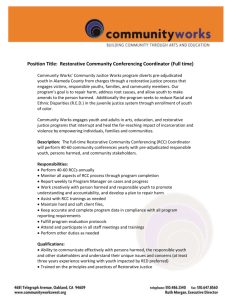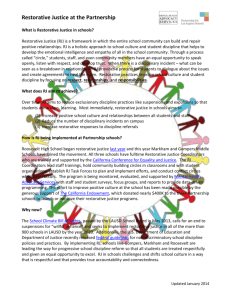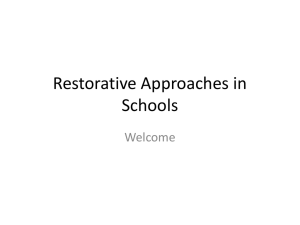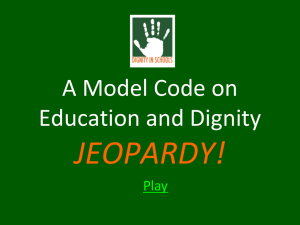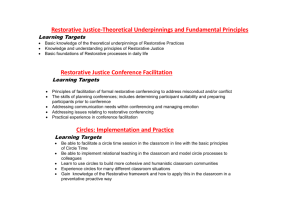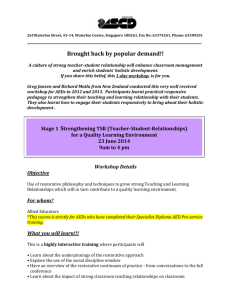Restorative Approaches in Schools: What is it? Restorative
advertisement
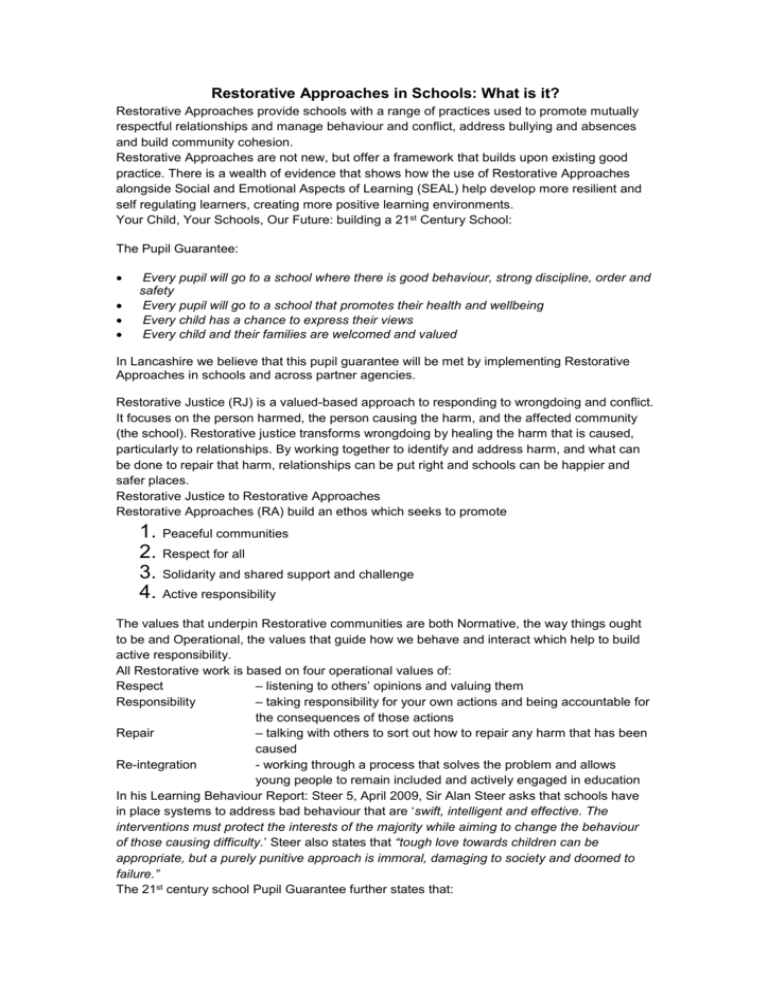
Restorative Approaches in Schools: What is it? Restorative Approaches provide schools with a range of practices used to promote mutually respectful relationships and manage behaviour and conflict, address bullying and absences and build community cohesion. Restorative Approaches are not new, but offer a framework that builds upon existing good practice. There is a wealth of evidence that shows how the use of Restorative Approaches alongside Social and Emotional Aspects of Learning (SEAL) help develop more resilient and self regulating learners, creating more positive learning environments. Your Child, Your Schools, Our Future: building a 21st Century School: The Pupil Guarantee: Every pupil will go to a school where there is good behaviour, strong discipline, order and safety Every pupil will go to a school that promotes their health and wellbeing Every child has a chance to express their views Every child and their families are welcomed and valued In Lancashire we believe that this pupil guarantee will be met by implementing Restorative Approaches in schools and across partner agencies. Restorative Justice (RJ) is a valued-based approach to responding to wrongdoing and conflict. It focuses on the person harmed, the person causing the harm, and the affected community (the school). Restorative justice transforms wrongdoing by healing the harm that is caused, particularly to relationships. By working together to identify and address harm, and what can be done to repair that harm, relationships can be put right and schools can be happier and safer places. Restorative Justice to Restorative Approaches Restorative Approaches (RA) build an ethos which seeks to promote 1. Peaceful communities 2. Respect for all 3. Solidarity and shared support and challenge 4. Active responsibility The values that underpin Restorative communities are both Normative, the way things ought to be and Operational, the values that guide how we behave and interact which help to build active responsibility. All Restorative work is based on four operational values of: Respect – listening to others’ opinions and valuing them Responsibility – taking responsibility for your own actions and being accountable for the consequences of those actions Repair – talking with others to sort out how to repair any harm that has been caused Re-integration - working through a process that solves the problem and allows young people to remain included and actively engaged in education In his Learning Behaviour Report: Steer 5, April 2009, Sir Alan Steer asks that schools have in place systems to address bad behaviour that are ‘swift, intelligent and effective. The interventions must protect the interests of the majority while aiming to change the behaviour of those causing difficulty.’ Steer also states that “tough love towards children can be appropriate, but a purely punitive approach is immoral, damaging to society and doomed to failure.” The 21st century school Pupil Guarantee further states that: Pupils know what behaviour is expected of them and the consequences of misbehaving, from September 2010 All pupils will have the opportunity to have a say about standards of behaviour in their school, from spring 2010 Pupils who need support for their behaviour outside the ordinary classroom have access to high-quality learning opportunities The White paper also commits to developing the skills of the workforce in addressing behaviour: ‘We will also support teachers and other members of the school workforce in developing the skills needed to tackle underlying learning difficulties that may give rise to behavioural problems. And we will build on the work of many schools over many years which have improved behaviour by involving pupils more in the setting of expectations for behaviour at school’. Restorative Approaches addresses these commitments and meets expectations. Restorative Approaches offer an opportunity for people on both sides of a conflict situation to take responsibility and be accountable for their own behaviour, understand the impact of harm caused to others and take steps to make amends and change behaviour for the future. A Restorative Approach is a paradigm change in the language we use to address conflict and inappropriate behaviour. In some schools we usually revert to the default mode of: What's happened? Who is to blame? And what do I need to do to punish the wrongdoer? In any incident of inappropriate behaviour we need to establish the facts. It is often said that there are three sides to every story: yours, mine and what really happened. Restorative questioning allows those involved to tell their story, from their perspective and to be listened to in a way that assures no pre-judgement. Restorative language then builds on 'affect' and feeling by asking 'Who has been affected by what has happened and in what way?' This helps to develop self awareness and awareness of the feelings of others which are two of the key aims of SEAL. The restorative approach is to challenge those who behave inappropriately to find a solution that is meaningful and meets the needs of those harmed. It is solution focussed, personal and more likely to build constructive and empathic bridges, rooting it firmly in SEAL. At all levels a Restorative Intervention involves bringing together everyone involved in an incident where harm has been caused. Using the five questions, all those involved talk about what has happened and how they and others have been affected. They then seek to find a way forward by deciding what is the best way for the harm to be repaired and what outcome would best meet their needs and ensure that the incident will not be repeated. A Restorative Intervention is voluntary for all those involved and paradoxically, it is the voluntary nature of the approach that encourages people to participate. "If children are making reparations rather than being punished, they need to be doing so in a context which clearly promotes personal and social well-being," Dr Cremin said. "Restorative justice has value, but we need to be very careful about the context in which young people may experience shame. Restorative approaches need to be used with skill and insight." Dr Hilary Cremin, Cambridge University Finally I’m not suggesting that restorative justice can be a panacea for all the challenges that schools face. However it can, and does, bring about positive changes. In my experience, it reduces the need to exclude young people and increases respect and understanding between all staff, learners and parents. In this way it develops more positive and supportive relationships. So while it may not be the answer to everything, it’s certainly worth considering as a tool for rebuilding broken relationships and making some repairs to damaged hearts.


